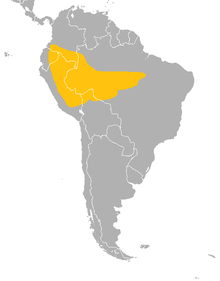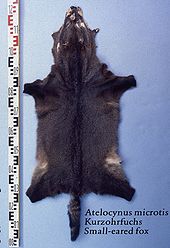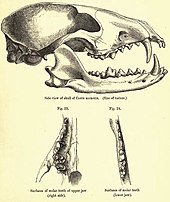| Short-eared dog | |
|---|---|

| |
| Conservation status | |
 Near Threatened (IUCN 3.1) | |
| Scientific classification | |
| Domain: | Eukaryota |
| Kingdom: | Animalia |
| Phylum: | Chordata |
| Class: | Mammalia |
| Order: | Carnivora |
| Family: | Canidae |
| Subfamily: | Caninae |
| Tribe: | Canini |
| Genus: | Atelocynus Cabrera, 1940 |
| Species: | A. microtis |
| Binomial name | |
| Atelocynus microtis (Sclater, 1883) | |
| Subspecies | |
| |

| |
| Short-eared dog range | |
The short-eared dog (Atelocynus microtis), also known as the short-eared zorro or small-eared dog, is a unique and elusive canid species endemic to the Amazonian basin. This is the only species assigned to the genus Atelocynus.
Other names
The short-eared dog has many names in the local languages where it is endemic, including cachorro-do-mato-de-orelha-curta in Portuguese, zorro de oreja corta ("short-ear fox") in Spanish, nomensarixi in Chiquitano, uálaca in Yucuna, cuachi yaguar in Guarayu, quinamco in Mooré, and achuj in Ninam and Mosetén.
Other common names in Spanish include zorro ojizarco ("blue-eyed fox"), zorro sabanero ("savannah fox"), and zorro negro ("black fox").
Evolution and systematics

After the formation of the Isthmus of Panama in the latter part the Tertiary (about 2.5 million years ago in the Pliocene), canids migrated from North America to the southern continent as part of the Great American Interchange. The short-eared dog's ancestors adapted to life in tropical rainforests, developing the requisite morphological and anatomical features. Although it has a superficial resemblance to the bush dog, the short-eared dog's closest living relative is the crab-eating fox. It is one of the most unusual canids.
Two subspecies of this canid are recognized, A. m. microtis and A. m. sclateri.
Occurrence and environment

The short-eared dog can be found in the Amazon rainforest region of South America (in Brazil, Bolivia, Peru, Colombia, Ecuador and possibly Venezuela). There is a single report of "three slender, doglike animals" of this species sighted in the Darien region of Panama in 1984 by German biologist Sigi Weisel and a native Embera-nation Panamanian; this rare species' presence in Panama is possible because of "the continuous mass of forest habitat that covers this region". It lives in various parts of the rainforest environment, preferring areas with little human disturbance. It lives in both lowland forests known as Floresta Amazônica and terra firme forest, as well as in swamp forest, stands of bamboo, and cloud forest. It is a solitary animal and prefers to remain under tree-cover, avoiding both human and other animal interaction.
Appearance


The short-eared dog has short and slender limbs with short and rounded ears. It has a distinctive fox-like muzzle and bushy tail. Its paws are partly webbed, helping adapt it to its partly aquatic habitat.
Its fur ranges from dark to reddish-grey, but can also be nearly navy blue, coffee brown, dark grey, or chestnut-grey to black, and the coat is short, with thick and bristly fur. It has a somewhat narrow chest, with dark color variation on the thorax merging to brighter, more reddish tones on the abdominal side of the body.
Diet
This wild dog is mainly a carnivore, with fish, insects, and small mammals making up the majority of its diet. An investigation led in the Cocha Cashu Biological Station in Peru into the proportions of different kinds of food in this animal's diet produced the following results:
Reproduction and behavior
This species has some unique behaviors not typical to other canids. Females of this species are about one-third larger than males. The excited male sprays a musk produced by the tail glands. It prefers a solitary lifestyle, in forest areas. It avoids humans in its natural environment. Agitated males raise the hairs on their backs.
The lifespan and gestation period of the short-eared dog are unknown, although sexual maturity is reached at three years of age, relatively late compared to other canid species.
Threats, survival, and ecological concerns
Feral dogs pose a prominent threat to the population of short-eared dogs, as they facilitate the spread of diseases such as canine distemper and rabies to the wild population. The short eared dog suffers greatly from loss of habitat. There is a significant amount of disturbance in formerly remote South American forests, and almost no habitat except where daily human settler and prospector traffic destroys or exposes their dens. Humans also contribute to their extermination by degradation of the species' natural habitat and the general destruction of tropical rainforests.
Status of conservation
The short-eared dog is currently considered near threatened by the IUCN. No comprehensive ecological and genetic research has been carried out on the species.
References
- ^ Wozencraft, W. C. (2005). "Order Carnivora". In Wilson, D. E.; Reeder, D. M. (eds.). Mammal Species of the World: A Taxonomic and Geographic Reference (3rd ed.). Johns Hopkins University Press. pp. 532–628. ISBN 978-0-8018-8221-0. OCLC 62265494.
- ^ Leite-Pitman, M.R.P.; Williams, R.S.R. (2011). "Atelocynus microtis". IUCN Red List of Threatened Species. 2011: e.T6924A12814890. doi:10.2305/IUCN.UK.2011-2.RLTS.T6924A12814890.en. Retrieved 19 November 2021.
- ^ Rosa, Carlos L. de la; Nocke, Claudia C. (2010-06-28). A Guide to the Carnivores of Central America: Natural History, Ecology, and Conservation. University of Texas Press. ISBN 978-0-292-78951-7.
- ^ Renata Leite Pitman; Robert S.R. Williams (2004). "The short eared dog (Atelocynus microtis) (Sclater, 1883)". In Claudio Sillero-Zubiri; Michael Hoffmann; David W. Macdonald (eds.). Canids: Foxes, Wolves, Jackals and Dogs: Status Survey and Conservation Action Plan (2004 ed.). IUCN, World Conservation Union. pp. 26–31. ISBN 9782831707860.
- Chavez, D.E.; Gronau, I.; Hains, T.; Dikow, R.B.; Frandsen, P.B.; Figueiró, H.V.; Garcez, F.S.; Tchaicka, L.; de Paula, R.C.; Rodrigues, F.H.G.; Jorge, R.S.P.; Lima, E.S.; Songsasen, N.; Johnson, W.E.; Eizirik, E.; Koepfli, K.P.; Wayne, R.K. (2022). "Comparative genomics uncovers the evolutionary history, demography, and molecular adaptations of South American canids". Proceedings of the National Academy of Sciences of the United States of America. 119 (34): e2205986119. Bibcode:2022PNAS..11905986C. doi:10.1073/pnas.2205986119. PMC 9407222. PMID 35969758.
- "Atelocynus microtis (Short-eared Dog, Short-eared Fox, Small-eared Dog, Small-eared Zorro)". redlist.org. Retrieved 2015-10-05.
- Giaimo, Cara (4 May 2020). "The ghost dogs of the Amazon get a bit less mysterious". The New York Times. ISSN 0362-4331. Retrieved 13 May 2020.
- "Atelocynus microtis: Information". ADW: Animal Diversity (animaldiversity.ummz.umich.edu). University of Michigan. Retrieved 2015-10-05.
- "Ecology and conservation of the short-eared dog (Atelocynus microtis)". Peru: Estación Biológica Cocha Cashu . Archived from the original on 16 October 2012. Retrieved 10 July 2024 – via Duke University (duke.edu).
- "Short-eared dog? Uncovering the secrets of one of the Amazon's most mysterious mammals". Mongabay Environmental News. 28 July 2014. Retrieved 25 July 2020.
Further reading
- Alderton, David (1998). Foxes, Wolves and Wild Dogs of the World. UK: Blandford Press.
- Nowak, Ronald (2005). Walker's Carnivores of the World. Baltimore, MD: The Johns Hopkins University Press.
External links
- IUCN/SSC Canid Specialist Group: Small Eared Zorro
- Pro-carnivoros
- Ecology and conservation of the short-eared dog by WildCru
- Studies with a tame short-eared dog by Maria Renata Leite
- Atelocynus microtis Research and Conservation by M. R. Pitman Leite
- PHOTOS: Short-Eared Dog Caught in Camera Trap
- Short-eared Dog video by Wink Gross on YouTube
- Short haired Dog Video 25 May 2014 National Geographic
| Taxon identifiers | |
|---|---|
| Atelocynus microtis | |
| Canis microtis | |